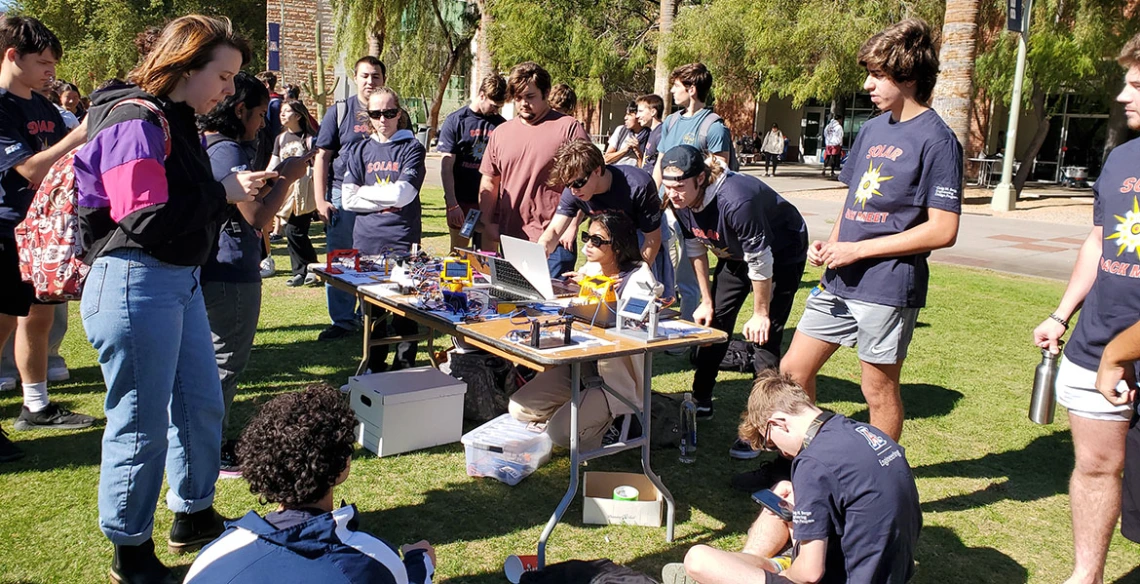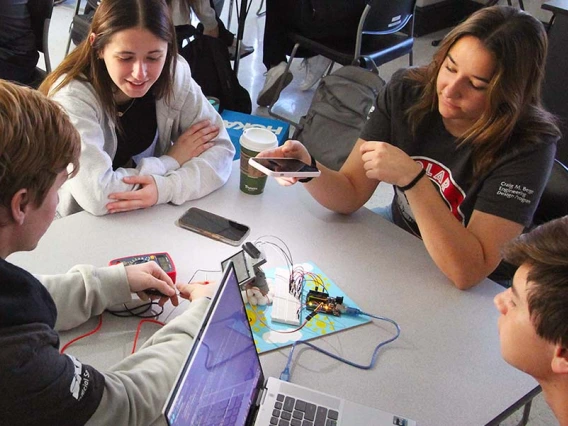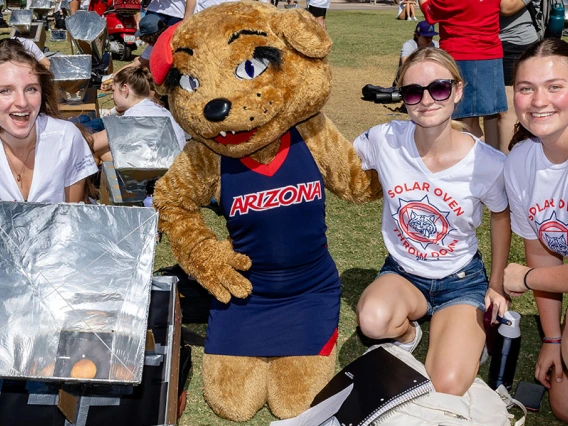Expanded Solar Track Meet Among Early Events in Four-Year Design Program
Salt River Project contributes expertise and funding for hands-on, first-year student project.

At the November 2023 Solar Track Meet, first-year students present their team-developed autonomous solar trackers for peer judging.
Students in the College of Engineering don’t wait long to begin projects that take them beyond equations and theory and head them toward exciting careers. As part of the college’s four-year design program and on the heels of the annual October Solar Oven Throw Down, the November Solar Track Meet gives first-year students even more hands-on experience.
“You don’t really feel like an engineer until you’ve built something tangible – something that moves around and interacts with the environment,” said Byron Hempel, chemical and environmental engineering assistant professor of practice and faculty coordinator for the meet.
With the support of the Salt River Project utility company, the college established the now expanded Solar Track Meet in 2022 for the Craig M. Berge Engineering Design Program. As soon as teams finish building solar ovens from common materials for the Solar Oven Throw Down, those teams move on to designing and building autonomous trackers that follow the sun’s movements to maximize collection of solar energy. Each student becomes certified in 3D printing, and every tracker includes at least one 3D-printed part.
The complex solar trackers use many integrative components, said Hempel. Team members draw on one another’s strengths as they build or source the solar tracker components, make the hardware and software interface, optimize for performance, and present their work for peer judging.
Unlike in 2022 when each class held its own Solar Track Meet, the 2023 event brought together 400 participating students for a single, unified gallery walk event on the University of Arizona Mall, where students judged one another’s projects for awards.
The Solar Track Meet and Solar Oven Throw Down are components of the curriculum for Engineering 102B, a required class for first-year students. For most students, these projects are their first two college design experiences. The undergraduate program culminates in Craig M. Berge Design Day, where seniors display real-life creations they have worked on with industry partners for an academic year.
Industry Partner Lends Real-World Perspective
Sponsor Salt River Project provided prize money as well as funds for project materials and event overhead. The utility company also supports engineering student clubs and partners on Craig M. Berge Design Day.
UA mechanical engineering alum Mary Faulk, SRP’s director of integrated system planning and support, finds it a privilege to mentor students and visit campus for the design events. The learning goes both ways, she said.
“I really enjoy hearing the creative ways that students troubleshoot, navigate teamwork challenges, and work through resource and time constraints,” said Faulk, stressing the underlying importance of effective communication.
“We actively demonstrate this in our daily work at SRP. Some examples would be proposing a new project to obtain funding, sharing a process improvement with another department to improve existing work, or explaining energy efficiency and cost-saving programs to our customers.”
Student teams competed for four awards in two categories: single- and dual-axis trackers. Prizes were awarded for overall performance, physical design, best coding, and best explanation of design.
“We broke up the different components of the solar tracker into categories, such as coding, design, proof of concept and electrical,” said Dominic Denha, a member of the 4GIG team, which won for best explanation among single-axis trackers. And, “We made sure we could explain each part in detail.”
Students Tap Into Multiple Makerspaces
The Engineering Design Center, which opened in February 2023 as the first collegewide makerspace, provides 24-hour access to space and equipment for students to learn 3D printing and construct their solar trackers. Students can also take a 3D printing certification class at CATalyst Studios, a campuswide makerspace, in the Main Library.
“We did everything in the Engineering Design Center, from the 3D printing to the soldering,” said Brian Ericsson, who was on the Solar Bears, the overall winning team for single-axis trackers. “It was a great experience overall, and it really showed how a like-minded team can get anything accomplished.”



